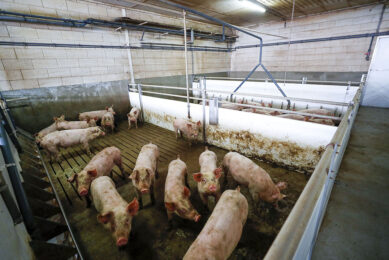How effective are pig cooling techniques?

Housing and equipment have a significant role to play in effectively combatting the negative effect of heat stress in pig herds, particularly in geographically warmer regions. Traditional methods of ventilation, alongside more innovative solutions like floor cooling are explored here.
Pigs are homeothermic animals that maintain body core temperature within narrow limits despite variations in the climatic environment. This capacity is achieved through thermoregulatory mechanisms that maintain a balance between heat production and heat loss mechanisms. When exposed to hot conditions, pigs maintain core temperature by increasing heat dissipation to the environment and by decreasing metabolic heat production.
Sensible and latent heat losses
Pigs dissipate heat to the environment mainly by 2 pathways:
- Sensible
- Latent heat losses
Sensible heat loss is a physical process (via conduction, convection and radiation) mainly dependent on the temperature gradient between the body and the exchange surface, and on the thickness and thermal conductivity of the exchange surfaces. Because sensible heat loss depends on a thermal gradient, it becomes less effective when ambient temperature approaches to body temperature. Therefore, pigs have to rely on latent heat loss to dissipate heat.
Latent heat loss does not require a temperature gradient but instead on the water vapour pressure gradient between the exchanges surfaces and the environment. Thus, an elevated air hygrometry can severely limit latent heat loss. In pigs, latent heat loss is mainly through increased respiratory rate, or panting, because they have relatively few and no functional sweat glands. For instance, Renaudeau et al. (2007) reported a linear increase in respiratory rate of 12 breaths per minute per each degree increase in ambient temperature above 26°C in growing pigs.
Management solutions to minimise effect
Due to the recognition that heat stress is a problem for pig production efficiency in regions with high temperatures, the objectives of many research trials in recent years have been to develop solutions to alleviate the negative effects of heat stress. Several management techniques have been tested but only a few ones were found effective and economical in minimising the impact of heat stress in pig production. These solutions include management strategies to reduce the building ambient temperature (fan, evaporative cooling system) and/or to increase animal heat losses (floor cooling, drip cooling, snout cooling). Moreover, some authors suggested that genetic selection can be used to improve pig’s resistance to heat stress. The nutritional alternatives cannot always completely reverse the negative effects of high temperatures. Thus, the use of environmental changes continues to be a favourable option in achieving significant improvements for physiological and performance factors of sows in gestation and lactation, and of their piglets. Among the alternatives used to reduce sow exposure to high ambient temperatures in the gestation rooms, the air conditioning system has been more efficient through evaporative cooling than forced ventilation to improve the thermal conditions of the facility, however, it must be used sparingly to minimise changes in humidity of the indoor environment.

A practical option is the optimisation of the natural ventilation systems through large openings on the side. The evaporative cooling systems work by changing the psychometric state of air, for a higher humidity and lowered temperature by contact with the surface of moistened liquid or air, or with sprinkled or sprayed water. As the vapour pressure of cooled unsaturated air is lower than the contact water, evaporation occurs; the heat required for this change of state comes from the sensible heat from the air and water, resulting in a decrease in temperature and thus the environment. The spray system consists of the formation of extremely small droplets, increasing the surface area of each water droplet exposed to air, ensuring faster evaporation. Nebulisation associated with the movement of air, caused by fans, accelerates evaporation and prevents spraying from occurring in one location, which could wet the bedding. The nebulisation of water without the use of fans or other control systems could lead to the wetting of the bedding or the exaggerated increase of the relative humidity of the area.
Optimum conditions for lactating sows
The critical temperature limits for sows during lactation are opposing conditions in relation to the comfort of the animals housed in them, because lactating sows can tolerate the cold well but not the heat, while the piglets need heat and are unable to tolerate the cold. Because of this, studies of alternatives to improve the environmental well-being for sows in maternity began, and consequently make it possible to enhance the productive and reproductive potential of the breeding stock. Among these alternatives, those that use a type of cooling system stand out. The ventilation systems have not been satisfactory, as they often do not reduce the air temperature.
Figure 1 – Floor cooling system design used during the experiment.

During the past years, we have been validating environmental strategies to improve heat exchange for sows during lactation such as, evaluating a floor-cooling system (Figure 1) for sows or even cooling of the drinking water. According to these findings, the increased density of the diet in a way compensates for the low consumption because of the heat, bringing benefits to the corporal condition of the sows without increasing milk production and no benefits in the gain of the piglets. While for the animals exposed to the floor cooling, significant changes in their physiological parameters were observed, as well as on performance and milk production, which resulted in a significant increase in piglet weight at weaning. Water chilling of lactating sows under heat stress was also investigated. Use of this system increased feed intake of sows by 20%, and improved milk production and piglet performance.
In conclusion, the detrimental effect of exposure to high ambient temperature and humidity fluctuations on performance of sows can be reduced by using effective cooling systems, allowing sows to maintain their homeothermia and therefore express their genetic potential.
References available on request
 Beheer
Beheer





 WP Admin
WP Admin  Bewerk bericht
Bewerk bericht